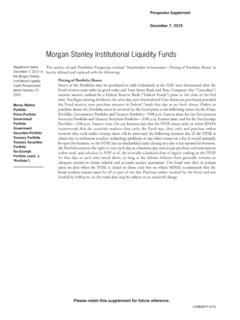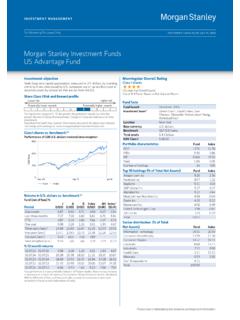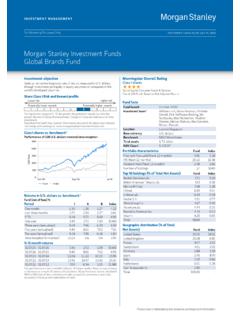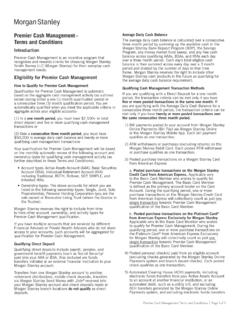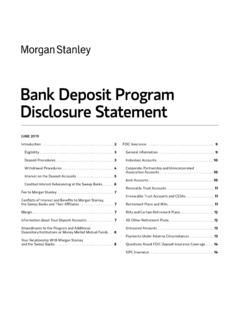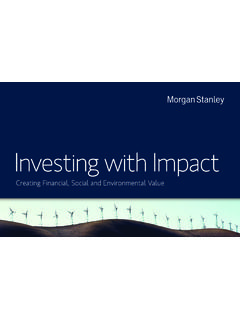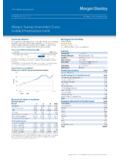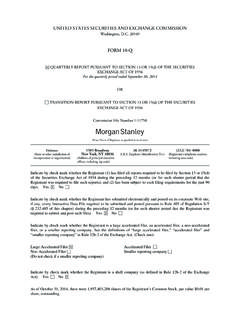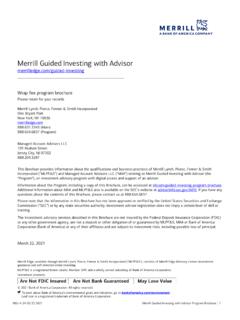Transcription of An Introduction to Alternative Risk Premia
1 SOLUTIONS & MULTI-ASSET | AIP HEDGE FUND TEAM | INVESTMENT INSIGHT | 2019CO-AUTHORSPATRICK REID, CFA Managing Director portfolio Advisor MARK VAN DER ZWAN, CFA Chief Investment Officer and Head of AIP Hedge Fund Team Alternatives investors have always been focused on the possibility of achieving a measure of downside protection, accessing differentiated exposures and identifying truly uncorrelated, complementary sources of return. In addition to conventional ways to modify multi-asset portfolios through incorporation of liquid alternatives, such as hedge funds and commodity trading advisors ( CTAs ), there has been an increase in the number of investors seeking newer ways to improve their much the same way that long-only investors have considered passive investing as a way to adjust their exposures efficiently and to reduce cost, alternatives investors have begun to explore systematic and index-based solutions such as Alternative risk Premia as a way to achieve those same objectives.
2 In this paper, we seek to introduce the concept of Alternative risk Premia , explain how investors can access them, and present the potential benefits and drawbacks associated with concept underlying Alternative risk Premia is the potential reward to an investor for taking on some form of risk. As the name suggests, this risk is Alternative to traditional market risk or traditional beta in the sense that it is non-correlating and tends to be structured in the form of a long/short investment. Alternative risk Premia tend to exhibit heterogeneous statistical An Introduction to Alternative Risk PremiaPlease refer to important disclaimers at the end of this INSIGHTMORGAN STANLEY INVESTMENT MANAGEMENT | SOLUTIONS & MULTI-ASSET properties, making them potentially diversifying building blocks to a broader multi-asset 1 highlights commonly used Alternative risk Premia , which often result from market behaviors or structural conditions. For example, herding behavior and instances in which investors chase winners and sell losers create momentum.
3 Mean reversion of asset prices to fair-value anchors often leads to opportunities classified as value. Investor mispricing of asset yields may lead to carry opportunities. In commodities markets, for example, carry is defined as the price differential between futures contracts of different maturities. This figure may be positive or negative because of supply and demand dynamics and other factors. The large derivatives market often provides opportunities to design novel Alternative risk Premia , both behavioral and structural, related to asset volatility. For example, during market crises, investors seek safer assets, and low volatility stocks tend to the term Alternative risk Premia is fairly new, investors have had exposure to these sorts of returns through hedge fund strategies like quantitative equity, macro and managed futures for many years. The key differences today are the ways investors access and implement having an understanding of Alternative risk Premia is important, what is attractive and compelling to investors is to think about their utility.
4 In our view, these Premia can be thought of as an extension of factor-based investing and can serve as building blocks for portfolio factor-based investing started with the Capital Asset Pricing Model ( CAPM ), which sought to explain investment performance using a risk-free rate and a single market risk factor or Over the years, it became increasingly apparent, through the groundbreaking research of Eugene Fama, Kenneth French and Mark Carhart, among others, that a single market risk premium was not the only driver of asset returns and that investors could exploit additional factors within or across asset More recent research suggests that investors can harvest Alternative risk Premia that persist because of human behavior and the structure of certain investment markets. Alternative risk Premia are of interest to investors because, unlike stocks and bonds, they are generally unrelated to broader macro fundamentals. Therefore, they can provide diversification benefits when included in portfolios alongside traditional of DistinctionThe terms Alternative risk Premia and smart beta are often lumped together.
5 However, in our view, there are important distinctions between the two: smart beta is generally derived from long-only investment strategies, whereas Alternative risk Premia are generally derived from long/short strategies with a number of them attempting to be William Sharpe, A Theory of Market Equilibrium under Conditions of Risk, The Journal of Finance, Volume 19, Issue 3 (1964).2 Eugene F. Fama, Kenneth R. French, Common Risk Factors in the Returns on Stocks and Bonds, Journal of Financial Economics, Volume 33, Issue 1 (1993). Mark M. Carhart, On Persistence in Mutual Fund Performance, The Journal of Finance, Volume 52, Issue 1 (1997).3 Clifford S. Asness, Tobias J. Moskowitz, Lasse Heje Pedersen, Value and Momentum Everywhere, The Journal of Finance, Volume 68, Issue 3 (2013).DISPL AY 1 Commonly Used Risk PremiaMICROI ndividualEquitiesMACROI ndices (Equity,Fixed Income,Commodities,FX, Rates)MomentumMomentumSizeTrendValueQual ityValueCurve LowVolatilityAcross Geographies CarryVolatilitySource: Morgan Stanley Investment Management.
6 For illustrative purposes only. Not an exhaustive Introduction TO Alternative RISK PREMIASOLUTIONS & MULTI-ASSET | MORGAN STANLEY INVESTMENT MANAGEMENTDISPL AY 2 Drivers of Investment ReturnsSource: Morgan Stanley Investment Management. For illustrative purposes is also important to note that Alternative risk Premia should not be confused with alpha, which reflects an idiosyncratic component of return believed to be derived from a manager s security selection and market-timing skill. Display 2 illustrates this distinction, as we see it, and provides a useful framework for considering the return sources that may comprise an absolute return portfolio Invests in Alternative Risk Premia ?Some of the earliest adopters of Alternative risk Premia strategies included sophisticated institutions, such as the Nordic and Scandinavian pension funds. Over time, the level of interest in these types of strategies particularly among institutional investors has grown. Today, investors are broadly diversified by geography and type: insurance companies, large institutions, endowments, risk Premia -specific asset managers and hedge fund expect growth to continue, and recent survey data seems to bear this out.
7 Of the 250 global institutional investors who responded to Morgan Capital Advisory Group s 2019 Institutional Investor Survey, 36% reported investing in or planning to invest in Alternative risk Premia . As illustrated in Display 3, this reflects the continuation of a multi-year Echoing similar expectations for continued growth, a report from bFinance suggested that after a huge wave of activity in 2016-2017, demand for Alternative risk Premia continues and seems to have settled at a more gentle pace. 5 Morgan s most recent survey seems to illustrate this AY 3 Continued Interest in Alternative Risk Premia40%30%20%0%2015 Yes, already invested No, but plan to do so next year2016201710%5%20%8%22%7%29%201812%24% Source: Morgan Capital Advisory Group. February 2019 Institutional Investor Survey, Morgan Capital Advisory Group (2019).5 Manager Intelligence and Market Trends, bFinance (August 2018).High Value AddedLow Value Added Opportunistic and dynamic decisions made by fund managersIdentifying returns from systematic exposure to Alternative sources of return harvested through long/short strategies Restructuring of index return sources to provide differentiated exposuresMarket Risks: BetaMarket TimingAlternative Risk PremiaStrategy ReturnsSkill-Driven: AlphaReturn SourcesSecurity Selection Identifying out/underperforming differentiated return sources through manager skill Fundamental factors, supply and demand Risk, rewards and correlations in major asset classes are well understoodMarket Returns4 INVESTMENT INSIGHTMORGAN STANLEY INVESTMENT MANAGEMENT | SOLUTIONS & MULTI-ASSET As investor interest in Alternative risk Premia has grown, so has recognition about the many ways these strategies can be used in portfolios.
8 Once mainly considered vehicles for constructing specific hedges, they are now regarded as a valuable asset allocation tool. In fact, respondents to Morgan s survey indicated that common reasons for investing in risk Premia strategies include isolating risk Premia exposures, low costs a nd l iqu id it Alternative Risk PremiaInvestors tend to implement Alternative risk Premia in three different ways:71. Purchasing them individually or in packages from banks in the form of bank swaps linked to bank-designed Alternative risk Premia Investing in a manager who designs its own risk Premia and runs them within a typical hedge fund or mutual fund Working with an asset manager who serves as a fiduciary , providing structuring, risk management and selection techniques on a customized must weigh the relative merits of each implementation SWAPWhen investors access Alternative risk Premia through a bank swap, they generally receive the return of an Alternative risk Premia index.
9 For example, if the index return is positive then the investor receives the index return less a set index fee. The bank swap is typically short maturity ( , one year) and it can roll, so the investor often has the option to increase or decrease the time horizon or the notional value of the swap. With an excess return index, the corresponding excess return swap requires no upfront cash funding from the investor. Depending on the International Swaps and Derivatives Association ( ISDA ) agreement, the investor may post collateral to the swap counterparty, the bank, between coupon payments as the swap s mark-to-market value varies. The main benefits of this implementation include liquidity, transparency and not having to fully fund the position. The drawbacks relate to the need to focus heavily on provider selection, Premia selection, portfolio oversight (which cannot be done by the bank as its role is counterparty, not portfolio manager), potential cost dispersion, and the operational inconvenience of implementation.
10 Setting up an ISDA and monitoring risk takes time and resources. Display 4 illustrates a typical bank swap an investor chooses to invest in a dedicated Alternative risk Premia fund, all investment selection and risk management decisions are outsourced to a fund manager. In this case, the investor commits 100% of the cash upfront and is subject to the same fund terms as other investors. The main advantage here is ease of implementation; the drawbacks include the requirement to be fully funded, fund fees and the lack of ability to customize or have to a fiduciary or asset manager seems to be a popular model among institutional investors. The fiduciary is often able to use its buying power to implement the bank swaps, potentially eliminating the requirement for an investor to fully fund, to obtain optimal pricing and to create a customized format. However, the fiduciary is required to provide the operational and oversight benefits of a fund AY 4 Bank Swap TransactionSource: Morgan Stanley Investment Management.
